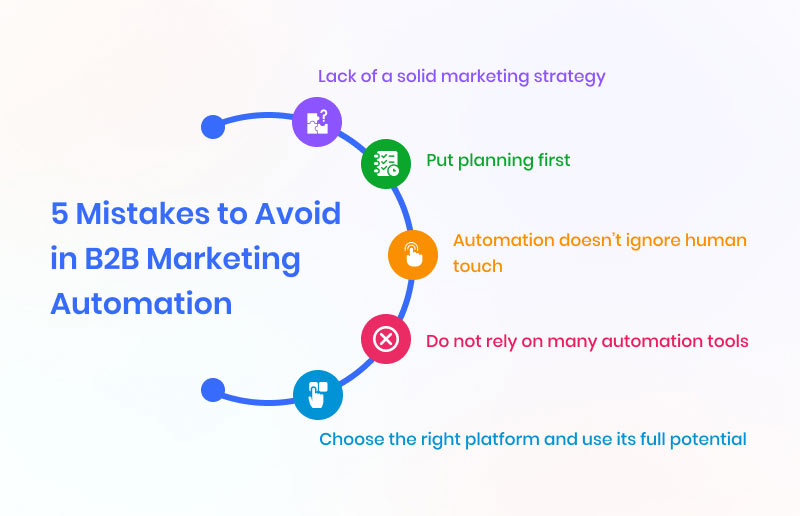The B2B automation market has become increasingly competitive. Building an effective marketing plan can be difficult with so many marketing system platforms, marketing channels, and audience segments to target, as well as a variety of messages and, offers to consider.
In addition to the challenges of choosing the best decision from so many options, many firms make it much more difficult to reach their marketing goals by making the same mistakes over and over again.
Now it’s time to look out for the mistakes and work on them to avoid huge losses. Let us get started.
Mistakes to Avoid in B2B Marketing Automation
As per Forrester reports, marketing automation technology’s worth would be bound to increase up to $25.1 billion by 2023. Many companies have already begun to explore the advantages of B2B marketing automation to build an omnichannel experience for their customers.
Beforehand, it is necessary to rectify the most common mistakes made by companies during their B2B Marketing automation process. Let us reveal it now.
Lacking a solid marketing strategy
Marketing Automation is unique and difficult on its own. When you fail to have a solid marketing strategy and go with the flow, then you may not reach your destination. But, skilled marketers have high empirical research with a data-hungry brain that works with full potential in promoting their brand.
They are realizing the benefits of marketing automation and have a solid marketing strategy. The success of marketing automation always has a cascading effect on your business.
Henceforth, if you wish to implement marketing automation in your business, always stick to a solid marketing strategy in order to gain more profit.
Put Planning First
Many marketers fail to note that marketing automation is not only for automating your emails. It is far behind that. According to SiriusDecisions, 85 percent of B2B marketers who employ automation solutions believe they aren’t exploiting them to their full potential. Part of the reason for this is that many people fall into the trap of solely using automation for emails.
Automation may be used for a lot more than just a weekly email. Automation can help with anything from lead generation & management to social media management, CRM, content marketing, and multi-channel campaign management.
Automation doesn’t ignore human touch
Marketing automation can help marketers and other business professionals streamline their procedures. Specific jobs and work processes can be automated to save time and allow staff to focus on higher-priority duties. However, especially when it comes to email content, it’s vital not to let automation take over every aspect of the work.
Customers want to feel as if they’re receiving a personalized message as if the marketer was thinking about them when creating an email campaign. As a result, marketers must avoid sending generic messages or utilizing inaccurate names in the text body.
Marketers must allow automation to make their jobs easier, but they must not allow technology to have an impact on a wide range of factors.
Do not rely on many automation tools
There are hundreds of marketing automation solutions to choose from, and it’s easy to get caught up in the trap of employing them all. When you use too many marketing automation tools, it’s easy to become overwhelmed and fall into the trap of under-utilizing them.
In most cases, marketing automation tools or solutions are used in conjunction with one another. That is why it is critical to choose an all-in-one platform that has all of the most crucial parts of marketing automation into a single platform. This will help you to streamline your operations and learn how to make the most of your software.
Here, an all-in-one marketing platform like Kartra is a huge help to businesses who need to manage the complete business from a single platform, and the cost of Kartra is worth the value it brings to business automation.
Choose the right platform and use its full potential
When automating your B2B marketing activities, one of the biggest mistakes you can make is not paying enough attention to how it integrates with your other business processes.
Your content marketing staff, for example, may be hard at work every week creating great posts. However, if you don’t link your email onboarding to evergreen content, you’re essentially missing out on an opportunity to properly introduce new subscribers to your products/services.
Alternatively, if you’re utilizing automation to increase landing page conversions, you might want to have a look at its capabilities and see whether it fits your marketing flow.
5 Best B2B Email Marketing Strategies to Consider
As we previously stated, one of the most common blunders made by new marketers is approaching their B2B and B2C email marketing tactics in the same way.
However, people buy items for a variety of reasons, depending on whether they are buying for business or pleasure. That implies you’ll have to change the way you write your email text.
It’s no surprise that a lot of individuals want to learn how to create B2B emails or use email templates. Here is the list of B2B email marketing strategies to keep in mind.
Personalization is Important
Email personalization has gone a long way from the days when “Hi [first name]” was the standard greeting. In fact, today’s email marketer has access to a variety of tools and customer data, allowing them to customize communications based on where a customer is in the purchase process.
Guessing who your target audience is and what they want won’t get you far. Existing customers can offer you the information and data you need to uncover the distinct yet common features of your ideal consumers. Buyer personas are defined as “clear yet shared features of your ideal clients.” This can include information like a person’s title, industry, demographic, psychographic, and geographic data, as well as other information.
Avoid over-promoting your product/service
Your email newsletter is for your customers, not for you. You should concentrate less on your firm and more on the topics and ideas that your customers care about. Articles with “how-to” recommendations, best practices, and concrete methods appeal to me.
Here are some examples of customer-focused email newsletter content to get you started:
- Problems and solutions – Identify typical issues that your clients confront and offer solutions.
- Lists and tips — Use names like “Seven Steps to…” or “The Top Five Ways to…” to create useful lists and tips.
- Technological advancements – Educate your consumers on how to make the most of recent technological advancements in order to be more productive.
- News and trends in your industry – Write about recent advancements in your field that your clients might benefit from.
- Write case studies about how other companies have improved their operations. Make sure to give actionable information that your customers may use to generate outcomes.
Make sure your articles are scannable and short. The greatest email newsletter pieces have a text length of 500 to 750 words. People generally skim information online before reading it in detail, so make your articles easy to scan by splitting up the text into small parts and highlighting significant content with bullet points and bolded headings.
Also, add images to your newsletter so it can engage better and support the content of your message. Websites providing free stock images can be an option to find free images.
Draft informative and triggering email
When people give you their email addresses, they expect to receive useful information and material. That’s why it’s critical to keep your messages focused and relevant to the context that prompted people to join your mailing list.
To put it another way, it all comes down to crafting the greatest email content possible based on your audience’s preferences.
According to studies, 62% of individuals open an email based just on the subject line. Subject lines are undeniably important in determining the open rates of any email campaign.
While the interests and nature of your audience will influence what will and won’t work to a great extent, here are some guidelines to help you improve your B2B email subject lines:
- Remove any spam words or symbols from your topic line.
- Aim for between 17 and 24 characters.
- Make your subject line as short as possible, ideally 3-5 words.
- In your topic line, use at least one emoji.
A/B testing your email subject lines will give you the information you need to make better decisions in the future, but this email subject line tester will also help you persuade people to read your email.
Send emails at regular intervals
When it comes to B2B email marketing, timing is essential. While the optimal times for each audience and organization are different, the data from your analytics can assist you to get the knowledge you need to figure out when the optimum time is to send your email.
Interruptions, pitches, and advertising are continually bombarding people. This is why it’s so important to maintain track of your whereabouts and be courteous.
When you get into someone’s email, it’s like being asked to dinner. You remove your shoes nicely if they ask you to. It’s the same with email marketing, so before we get started, remember that you’re a visitor in their inbox. As a result, make it a habit to send emails on a frequent basis.
Maintain a clean database
If you want to keep your email content on track, segment your list according to your audience’s level of interest in your business.
You can send personally relevant material to your readers by segmenting your list depending on their interests and communication choices. So, how do you acquire the data you require?
To begin, ask them a few questions about their interests, priorities, and preferences as they join up.
A segmentation program can help you divide your audiences based on demographics, age, income, previous purchases, email receptivity, and other characteristics. This will assist you in customizing the content and enhancing brand perception.
Final Takeaway
B2B marketing automation is something that I am very interested in.
Many businesses have found it to be a game-changer, allowing them to accomplish much more and give a better client experience with very few staff.
To put it another way, marketing automation resulted in a 12.2 percent reduction in marketing expenses and a 14.5 percent boost in sales productivity, according to one study. So it’s a no-brainer to use it.
The B2B marketing automation mistakes and email marketing tactics I have described here should give you an idea of some of the options available and possibly inspire you to get started.










